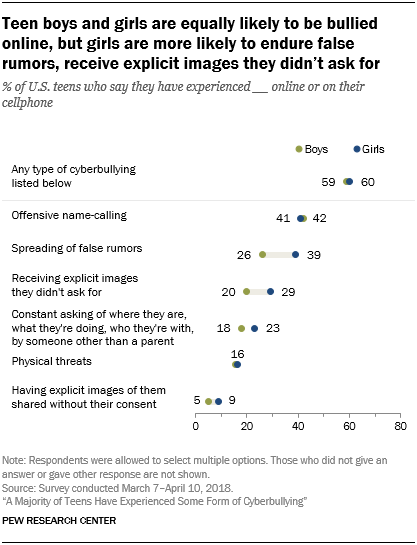A Majority of Teens Have Experienced Some Form of Cyberbullying
59% of U.S. teens have been bullied or harassed online, and a similar share says it's a major problem for people their age. At the same time, teens mostly think teachers, social media companies and politicians are failing at addressing this issue.
 Name-calling and rumor-spreading have long been an unpleasant and challenging aspect of adolescent life. But the proliferation of smartphones and the rise of social media has transformed where, when and how bullying takes place. A new Pew Research Center survey finds that 59% of U.S. teens have personally experienced at least one of six types of abusive online behaviors.1
Name-calling and rumor-spreading have long been an unpleasant and challenging aspect of adolescent life. But the proliferation of smartphones and the rise of social media has transformed where, when and how bullying takes place. A new Pew Research Center survey finds that 59% of U.S. teens have personally experienced at least one of six types of abusive online behaviors.1
The most common type of harassment youth encounter online is name-calling. Some 42% of teens say they have been called offensive names online or via their cellphone. Additionally, about a third (32%) of teens say someone has spread false rumors about them on the internet, while smaller shares have had someone other than a parent constantly ask where they are, who they’re with or what they’re doing (21%) or have been the target of physical threats online (16%).
While texting and digital messaging are a central way teens build and maintain relationships, this level of connectivity may lead to potentially troubling and nonconsensual exchanges. One-quarter of teens say they have been sent explicit images they didn’t ask for, while 7% say someone has shared explicit images of them without their consent. These experiences are particularly concerning to parents. Fully 57% of parents of teens say they worry about their teen receiving or sending explicit images, including about one-quarter who say this worries them a lot, according to a separate Center survey of parents.
The vast majority of teens (90% in this case) believe online harassment is a problem that affects people their age, and 63% say this is a major problem. But majorities of young people think key groups, such as teachers, social media companies and politicians are failing at tackling this issue. By contrast, teens have a more positive assessment of the way parents are addressing cyberbullying.
These are some of the key findings from the Center’s surveys of 743 teens and 1,058 parents living in the U.S. conducted March 7 to April 10, 2018. Throughout the report, “teens” refers to those ages 13 to 17, and “parents of teens” are those who are the parent or guardian of someone in that age range.
Similar shares of boys and girls have been harassed online – but girls are more likely to be the targets of online rumor-spreading or nonconsensual explicit messages
 When it comes to the overall findings on the six experiences measured in this survey, teenage boys and girls are equally likely to experience cyberbullying. However, there are some differences in the specific types of harassment they encounter.
When it comes to the overall findings on the six experiences measured in this survey, teenage boys and girls are equally likely to experience cyberbullying. However, there are some differences in the specific types of harassment they encounter.
Overall, 60% of girls and 59% of boys have experienced at least one of six abusive online behaviors. While similar shares of boys and girls have encountered abuse, such as name-calling or physical threats online, other forms of cyberbullying are more prevalent among girls. Some 39% of girls say someone has spread false rumors about them online, compared with 26% of boys who say this.
Girls also are more likely than boys to report being the recipient of explicit images they did not ask for (29% vs. 20%). And being the target of these types of messages is an especially common experience for older girls: 35% of girls ages 15 to 17 say they have received Continue reading: A Majority of Teens Have Experienced Some Form of Cyberbullying | Pew Research Center

